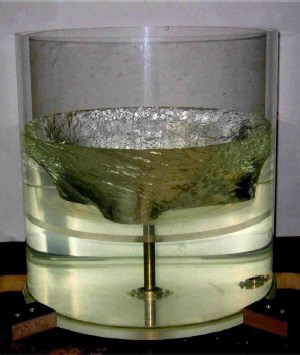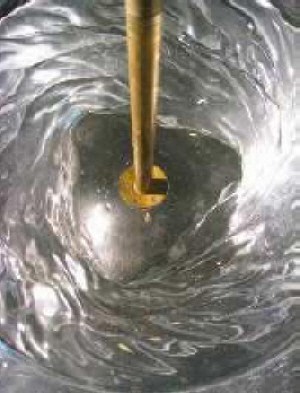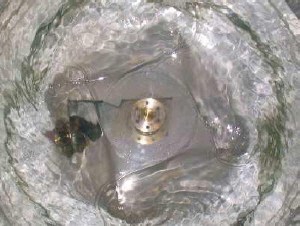What happens when you rapidly rotate the bottom plate of an otherwise stationary cylinder filled with water? According to new work by physicists in Denmark, you produce rotating polygons with up to six corners on the water's surface. This new and spectacular type of "instability" could be used to study a wide variety of complex systems in physics, including rotating flows on Earth, hydraulic machinery in industry, vortices and tornadoes (Phys. Rev. Lett. 96 174502).

Rotating flows are important in classical fluid dynamics and can produce interesting unstable structures, such as vortices. Since the Earth rotates, such flows are also of interest in geophysics (in the oceans or atmosphere) and in engineering, where they are often found in hydraulic turbo machinery. Moreover, rotating containers can be used to study vortices in experiments and obtain information about natural phenomena such as tornadoes.
The new experiment is an extremely simple example of a “Newton’s bucket” — so-called because Isaac Newton originally used a rotating bucket to discuss the origins of the centrifugal force, which pushes a fluid out against the wall of its container. The present study, performed by Tomas Bohr and colleagues at the Technical University of Denmark in Kongens Lyngby and the Niels Bohr Institute in Copenhagen, is different because the sides of the bucket remain still while only the bottom rotates.
The bucket is made of Plexiglas, is about 20 cm across and contains a rotating plate underneath (figure 1). Bohr and co-workers fill the container with water and set the plate rotating. When the rotation rate becomes sufficiently large, deformations in the form of polygons with up to six corners appear on the surface of the fluid (figure 2).
When the researchers used ethylene glycol, which is about 15 times more viscous than water, they observed three-cornered polygons (figure 3). In some cases, they even saw vortices at the edge of the polygon’s corners (figure 4).
According to the Denmark team, the polygons are new members of a fascinating class of systems where spontaneous breaking of axial symmetry leads to simple stationary or rigidly rotating shapes. Existing members of this family include wavy vortex flows in the “Couette-Taylor” system and classical “Kelvin-Helmhotz-Rayleigh” shears.
The scientists still do not completely understand why the polygons form but now plan to repeat the experiment with buckets of different diameters and fluids that are more viscous. “The variation with these parameters should give us significant information about the origin of the structures,” says Bohr.






